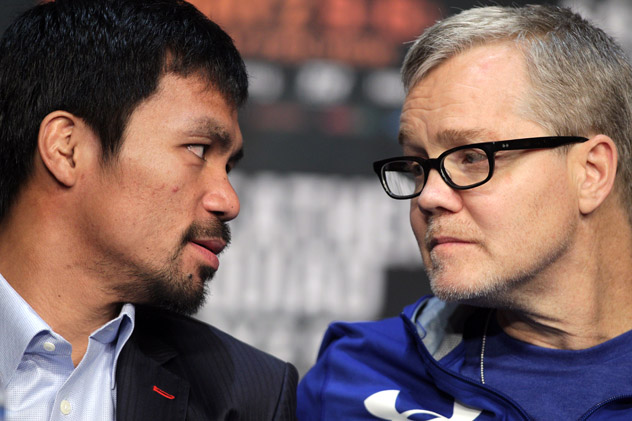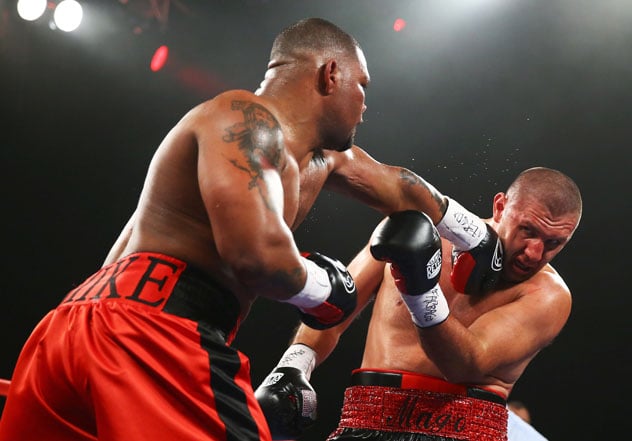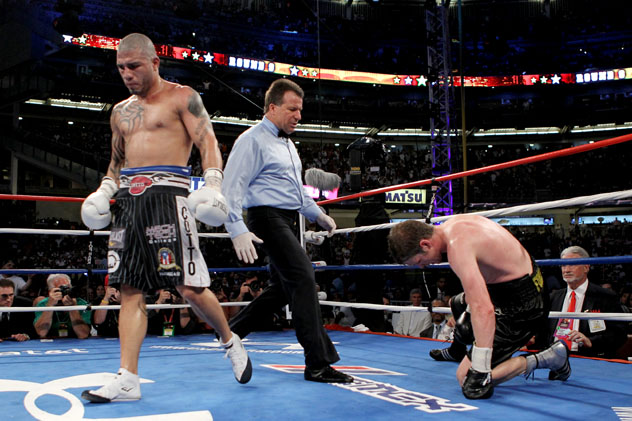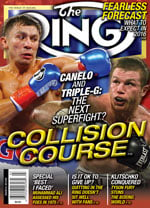NYSAC under fire: The Inspector General’s investigation – Part I

This is the first in a five-part series on the Inspector General of the State of New York’s investigation of the New York State Athletic Commission.
***
Russian heavyweight Magomed Abdusalamov fought Mike Perez on Nov. 2, 2013, at Madison Square Garden. Hours later, Abdusalamov was in a coma following the removal of a portion of his skull and other surgical procedures to treat bleeding and swelling in his brain.
Abdusalamov will never have a normal life. He’s partially paralyzed on his right side, cannot walk and has limited control over the rest of his body. He recognizes family members and close friends but is unable to carry on a coherent conversation. He struggles to make sounds that resemble words but can communicate thoughts like hello, goodbye, yes and no. He points to his mouth when he’s hungry. He understands simple instructions and can identify shapes and colors by pointing on command. It’s impossible to quantify his cognitive abilities and know how much he understands.

Photo by Al Bello/Getty Images
The Abdusalamov tragedy set a chain of events into motion. In January 2014, his family filed a notice of claim with the New York State Court of Claims against the New York State Athletic Commission and the State of New York. On March 26, 2014, they filed suit in New York State Supreme Court against five commission doctors (Barry Jordan, Anthony Curreri, Osric King, Gerard Varlotta and Avery Browne), Matt Farrago (the NYSAC inspector assigned to Abdusalamov’s dressing room), Benjy Esteves (who refereed the fight), K2 Promotions (which promoted the bout) and Madison Square Garden.
Some of the plaintiff’s claims seem unfounded on their face. For example, Dr. Browne was the ringside physician assigned to Perez’s corner and had nothing to do with Abdusalamov’s medical care. Nor were K2 Promotions and Madison Square Garden responsible for the conduct of the fight or Abdusalamov’s post-fight medical treatment. Madison Square Garden was dismissed from the lawsuit on Feb. 26, 2015. The dismissal of claims against Browne and K2 is expected to follow in the near future.
That said, many of the plaintiffs’ claims raise serious issues.
On June 23, 2015, the New York State Attorney General filed suit against five members of Abdusalamov’s team (including trainer John David Jackson), claiming that, if Abdusalamov suffered any injuries as a result of negligence, such negligence lay in the failure of his own team to fulfill its responsibilities with regard to stopping the fight, ensuring clear communication with commission personnel regarding Magomed’s condition and pursuing the use of an ambulance to transport him to a hospital.
Because of procedural maneuvering, only one deposition (that of Matt Farrago) has been taken in the litigation to date.
The Abdusalamov tragedy led to an external investigation of the New York State Athletic Commission. On Nov. 11, 2013, Secretary of State Cesar Perales (who has oversight responsibilities with regard to the NYSAC) sent a letter to Catherine Leahy Scott (the Inspector General of the State of New York), asking that her office “determine whether the policies and procedures in place to protect the fighters were properly administered in connection with the fight” and “take all other actions that you deem necessary and appropriate.”
The Inspector General’s office is a government monitoring agency. Its investigations are often criminal in nature. But the office is also charged with uncovering abuse in state government and identifying which systems and protocols aren’t working properly.
This wasn’t the first time the Inspector General’s office investigated the New York State Athletic Commission. Most notably, in March 2000, a New York County assistant district attorney assigned to the Rackets Bureau advised the Inspector General’s office of alleged improprieties by NYSAC officials. This came at a time when the NYSAC had become a microcosm of incompetence and corruption and a dumping ground for Republican-party political patronage employees.
The Inspector General’s investigation of that unfortunate era unearthed numerous no-show jobs. As outlined in the Inspector General’s report, an NYSAC satellite office in Poughkeepsie that was rented from a politically-connected landlord was used so infrequently that NYSAC mail sent there went unopened for months. Eventually, all NYSAC mail sent to the Poughkeepsie office was returned to the parties who had sent it. One commission employee with a no-show job and state cell phone accumulated more than $400 in monthly phone charges on a regular basis. On one occasion, his monthly bill exceeded $1,500. A review by the Inspector General’s office showed that most of his calls were personal, not NYSAC-related.
By contrast, the Inspector General’s inquiry into the Abdusalamov tragedy began, not as an investigation of corruption, but as a review of the NYSAC’s medical practices and an inquiry into whether Magomed received adequate medical care. However, it soon expanded into a broader study of the overall operation of the commission during the tenure of Chairperson Melvina Lathan.
The available information suggests that the Inspector General’s staff members conducted their investigation diligently and conscientiously. Their written report was largely complete in December 2014. Third parties (including this writer) were advised that the report would be released by January 2015 in accord with the following protocol.
The report would be sent initially to the Secretary of State, who would forward it to the New York State Athletic Commission for comment. The Secretary of State and NYSAC would have 10 days to review the findings and recommendations contained in the report and send their comments to the Inspector General’s Office. Then, subject to possible revision, the report would be posted on the Inspector General’s website with the commission’s comments.
But that’s not what happened. The report was never released. John Milgrim (a special deputy who handles media inquiries for the Inspector General’s office) says that’s because “the investigation is ongoing.”
Other sources (including several in state government) say they believe that a “political hold” has been put on the report to save the governor’s office from embarrassment and make it more difficult for the Abdusalamov family to pursue its lawsuit against the State of New York, the New York State Athletic Commission and some of the other defendants.
Milgrim rejects that notion, saying, “There has been no contact whatsoever between this office and anyone in the governor’s office regarding this investigation.”
During the course of its investigation, the Inspector General’s office interviewed dozens of individuals. I should note that I was interviewed by investigators on Jan. 2, 2014. In addition to myself, those present at the interview were Philip Foglia (deputy inspector general and chief of investigations), Kenneth Michaels (investigative counsel), Robert Werner (chief investigator), and Alla Korsunskiy (a forensic accountant). I also spoke with representatives of the Inspector General’s office on several later occasions.
Pursuant to New York’s Freedom of Information Law, I now have transcripts of 34 interviews conducted by the Inspector General’s office, 13 additional interviews in audio format and hundreds of documents that have been gathered by the Inspector General’s staff during the course of its investigation.
The article that follows is based in part on these transcripts, recordings and documents. The material in them goes far beyond Abdusalamov. It also deals with allegations of wrongdoing and incompetence by certain New York State Athletic Commission officials.
I should emphasize that there are many dedicated, hard-working, competent people who have worked and continue to work for the New York State Athletic Commission, including some whose lives intersected with Abdusalamov and the other events described below.
Some of the transcripts that were produced by the Inspector General’s office contain redactions (i.e. some material was blacked out). These redactions were made by a combination of people in the Inspector General’s office based on claims of attorney-client privilege, the attorney work-product doctrine and the Health Insurance Portability and Accountability Act.
In writing this article, I’ve edited the interview testimony down to manageable size in an effort to report effectively, fairly and accurately on the issues at hand.
***
The tragedy that befell Magomed Abdusalamov didn’t happen in a vacuum.
The New York State Athletic Commission has better-qualified ring doctors and better medical protocols that most jurisdictions. But in recent years, medical oversight has sometimes been lax.
Melvina Lathan was appointed to the NYSAC as one of three commissioners by Governor Eliot Spitzer in 2007. At the start of her term, the commission chairman was Ron Scott Stevens. On March 17, 2008, Spitzer resigned in the wake of a prostitution scandal and was replaced by Lieutenant Governor David Paterson. Four months later, Paterson removed Stevens from his post and replaced him with Lathan.
State athletic commissions don’t “run” boxing. They regulate events. At the championship level where big money is generated, the sport is controlled by a handful of promoters, television executives and world sanctioning body officials. In these situations, one hopes that a state athletic commission will do three things: 1. enforce the laws that are in place regarding financial matters (most notably, the Muhammad Ali Boxing Reform Act); 2. administer a fair fight; and 3. protect the health and safety of fighters in a reasonable manner.
The health and safety of fighters insofar as the conduct of state athletic commission officials is concerned is dependent upon the enforcement of proper pre-fight medical standards and the performance of commission officials (most notably, the referee and ring doctors) on fight night. There are three primary areas of involvement: 1. who is allowed to fight; 2. whether or not a fight should be stopped; and 3. post-fight medical care.
These are important responsibilities. Lives are at stake.
During Lathan’s tenure as NYSAC chairperson, the already dangerous job of fighting was sometimes more dangerous than necessary. The most flagrant example of this involved the June 5, 2010, championship fight at Yankee Stadium between Miguel Cotto and Yuri Foreman.
Forty-five seconds into Round 7 of that fight, as Foreman was moving laterally to his right along the ring perimeter, his right knee gave way and he fell hard to the canvas. He rose in obvious pain, hobbling when he tried to walk.
“Walk it off, champ,” referee Arthur Mercante Jr. told him. “Suck it up, kid. I’ll give you five minutes.”

Photo by Al Bello/Getty Images
Foreman wanted to continue fighting. Less than a minute after he went down, the action resumed. At that point, he was a seriously compromised fighter. Forty-five seconds later, again with no punch being thrown, Foreman’s knee buckled and he fell once more to the canvas.
During the one-minute break after Round 7, trainer Joe Grier readied Foreman for the next stanza, hoping that his fighter could regain his mobility. But it was quickly clear that, not only couldn’t Foreman move to avoid punches, he couldn’t get power on his own blows. At the 1:30 mark, while trying to move laterally, he staggered and almost fell again. At that point, following proper procedure, Grier asked Ernie Morales (the NYSAC inspector assigned to Foreman’s corner) to tell the referee that he wanted to stop the fight. Morales stood on the ring apron and got Mercante’s attention. But the referee ignored the request.
“Yuri was starting to get banged up,” Grier recounted later. “He couldn’t properly defend himself because he only had one leg. The referee wasn’t listening to the inspector. I had to get it stopped. I asked if I could throw the towel in and the inspector said ‘go ahead.'”
With 1:15 left in Round 8, Grier threw a white towel into the ring. Both corners came through the ropes to embrace their respective fighters. At that point, the referee shouted, “Everybody out of the ring. I don’t want the towel. The corner is not throwing in the towel.”
Grier didn’t force the issue because he feared that, if he did, the commission would withhold Foreman’s purse. The action resumed. Foreman was no longer able to properly defend himself. The fight was clearly unwinnable. Yuri’s knee gave way and he staggered several more times before the end of the round. Thirty seconds into Round 9, Cotto landed a hook to the body. Foreman’s knee gave out again and he fell to the canvas. Finally, Mercante stopped the fight.
Six days later, Foreman underwent reconstructive surgery for a torn ACL and torn meniscus muscle in his right knee. He was never the same fighter again.
It has been an unwritten rule in boxing, honored for over a century, that, when a fighter’s corner wants to stop a fight, the fight is stopped. A comprehensive look at the NYSAC’s handling of Foreman-Cotto is detailed in a story at secondsout.com.
Some other thoughts follow:
- Al Bernstein: “I’ve been a commentator for literally thousands of fights and I’ve never seen anything like that before. It’s a time-honored tradition in boxing and a common sense rule: If the corner wants to stop a fight, the referee should stop the fight. This was horrible. Just horrible.”
- Naazim Richardson: “If I want it stopped, if I think my guy’s health is in danger and the referee won’t stop it, that’s crazy. This isn’t something we should even be having a debate about. You cannot overrule the trainer if he wants to stop the fight. It’s dangerous. It’s wrong. Something like that has no place in boxing.”
- Dan Birmingham: “It was blatantly wrong. Anyone who doesn’t understand that doesn’t understand boxing. I mean, really. Come on. What was the referee looking at? This isn’t a game. Just because he wants to thrill the crowd, he lets the fight continue? That’s scary. Thinking like that is dangerous. I don’t care if you’re talking about a four-round club fight or a world championship fight. That kind of thinking has no place in boxing. If the corner stops a fight too soon, so be it. At least then, no one dies. And make no mistake about it: Lives are at stake.”
Larry Hazzard is uniquely qualified to comment on situations of this nature, having been inducted into the International Boxing Hall of Fame for his work as a referee and commissioner of the New Jersey State Athletic Control Board. Hazzard had this to say about Cotto-Foreman.
“Normally, I don’t comment on situations involving a referee and a commission. And I don’t like to criticize. But I’d be doing a disservice to the boxing community if I didn’t speak out.”
“You have to look at the total situation,” Hazzard explained. “The most important mission of the referee is to protect the health and safety of the fighter. Fighters are in danger every time they step into the ring. It’s the referee’s job to protect them when the danger becomes too great. The referee’s mission is not to tell the fighter, ‘Suck it up. Walk it off.’ Walk it off? What does that mean? The referee should have called in the doctor when the fighter’s knee gave out. Instead, the referee, on his own, made a medical decision that the fighter should continue. One thing we should all agree on is that the referee is not empowered to make medical decisions. That’s why we have a doctor in each corner. You call time and consult with the doctor. How can anyone argue with that? Suck it up and walk it off. What kind of refereeing is that?”
It’s easy to criticize Mercante for his actions in Cotto-Foreman. But the overall handling of the situation represented a system-wide failure.
Hazzard highlighted this point, when he said, “The fighter was hurt and shouldn’t have been allowed to continue. If the referee couldn’t see it, that’s why you have other safeguards in place. Where was the ring doctor in all of this? Where was the rest of the commission? I know the corner inspector did his job but where was everybody else? And how can you overrule the trainer when he wants to stop the fight? Nobody knows a fighter better than his trainer. When the inspector came up on the ring apron and told the referee that the trainer wanted the fight to be over, that should have been it. When Mercante threw the inspector out of the ring, what he was doing, really, was throwing the commission, which is represented by the inspector, out of the ring. He was throwing all the rules and a hundred years of boxing out of the ring. Right then, someone should have taken the fight out of his hands because, clearly, at that point, he wasn’t acting properly.”
“I hate to be this critical,” Hazzard said in closing. “It’s not my goal to criticize or upstage anyone. But I feel like I have to speak out. The actions that were taken on the night of the fight were totally incorrect. The way this fight was handled was horrible. In the whole history of boxing, to my knowledge, nothing like this has ever happened before. And it should never happen again.”
Dr. Barry Jordan (the current chief medical officer for the NYSAC) was asked about Cotto-Foreman by the Inspector General’s office. Excerpts from the transcript of that session read as follows.
Q: There’s been some conversation about the Cotto-Foreman fight at Yankee Stadium. Are you familiar with that fight?
Dr. Jordan: Yes.
Q: Were you in attendance?
Dr. Jordan: No. I was watching it on television.
Q: Having watched it on television, did you have any concerns about that fight where Foreman slipped and fell down and his knee gave out and he clearly had less mobility?
Dr. Jordan: Yes, I did. I feel uncomfortable saying what my concerns were only because I don’t want to criticize co-workers. But if I was working that night, I would have stopped the fight.
Cotto-Foreman was an example of how, at times, the NYSAC played Russian roulette with fighter safety. Lathan was at ringside during the fight and ruled that it should continue after Foreman’s corner asked that it be stopped and a towel was thrown into the ring. Later, she told Michael Woods of TheSweetScience.com, “I think Arthur did a remarkable job. He did what he was supposed to do. He knows the rules. He responded appropriately. All in all, it was a magical evening of boxing.”
Lathan also raised eyebrows with her handling of the Dec. 3, 2011, fight between Miguel Cotto and Antonio Margarito at Madison Square Garden.
Dr. Jordan, Dr. Anthony Curreri (the NYSAC’s ocular specialist), and the commission’s medical advisory board (including retinal specialist Dr. Vincent Giovinazzo) were unanimous in the belief that Margarito should not be licensed to box in New York. In making that determination, they considered five problems Margarito faced after his 2010 fight against Manny Pacquiao: 1. a retinal detachment; 2. a large retinal tear necessitating the use of silicone oil as part of the repair process; 3. a fractured orbital bone; 4. a vitreous rupture; and 5. the removal of a cataract followed by the implant of an artificial lens. Taken together, these factors led to further concern regarding the total construction of Margarito’s right eye.
Still, Lathan attended a kick-off press conference for the fight and allowed pre-fight planning to proceed until after Madison Square Garden was sold out for the bout. She then moved to deny Margarito a license to box on medical grounds, ran into a firestorm of protest and chaired a NYSAC meeting in camera at which Margarito was licensed, supposedly on the basis of a medical report submitted by an ocular specialist named Thomas Goldstein.
However, it’s clear from a reading of the transcripts produced by the Inspector General’s office (including an April 28, 2014, interview with Lathan) that Dr. Goldstein’s written report stated that Margarito was unfit to box. In that regard, the following exchange with Lathan is instructive.
Q: Was there any discussion about his [Dr. Goldstein’s] written report?
Lathan: I don’t think we [the three commissioners who cleared Margarito to fight] ever really read it. I mean, first of all, it’s medical in nature. I read it. I don’t understand what I read.
Q: Well, you understand the last part.
Lathan: Yeah. You know, forgive me, I think that night [when the commission met] I had – I was – had a temperature of 103 or 104. I had the chills. I couldn’t talk. So I don’t know. I don’t say that’s an excuse, but I can’t recall what – when or how, what made us change anything. I remember listening to this person [Dr. Goldstein] and the way he spoke, what he said, was letting us know, in essence, that it was okay. And we had decided that we were going to go with whatever direction this person took us. That’s what I’m recalling.”
Barry Jordan was also asked about Margarito by the Inspector General’s office and the following exchange occurred.
Q: What do you remember about that situation?
Dr. Jordan: I remember quite vividly. I denied him a license.
Q: Why did you deny him the license?
Dr. Jordan: He didn’t fulfill our requirements.
Q: For medical reasons?
Dr. Jordan: Right.
Q: It was all about his eye?
Dr. Jordan: His eye, right. And I want to emphasize that my primary responsibility is to the health and safety of the boxer.
Q: So what happened?
Dr. Jordan: The commission had a hearing and they overruled me.
Q: Are those hearings routine? Have they happened before in your experience?
Dr. Jordan: This is the first [and last] time I’ve ever been overruled. And actually, to be quite honest, the physicians that were involved, Dr. Curreri and Dr. Giovinazzo, they were both rather upset, as was I.
Cotto-Margarito was stopped after nine rounds because Margarito’s right eye was swollen shut and Dr. Curreri (the ring doctor assigned to his corner) ruled that the bout should not continue.
A motorist can run a red light 10 times without adverse consequences. Then, one day, there’s a truck. The New York State Athletic Commission was running red lights with regard to fighter safety. That brings us to Magomed Abdusalamov.
***
Go to Part II of “The New York State Inspector General’s Investigation.”
Thomas Hauser can be reached by email at [email protected]. His most recent book (A Hurting Sport: An Inside Look at Another Year in Boxing) was published by the University of Arkansas Press
















